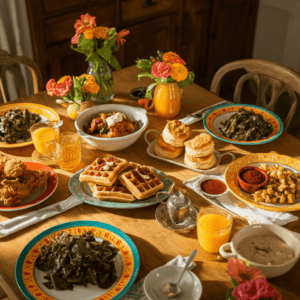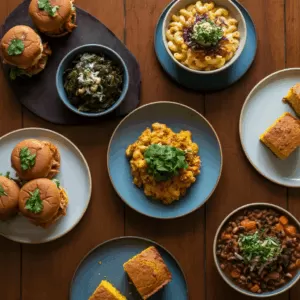Hosting a DIY Soul Food Catering event is a fantastic way to bring family and friends together while celebrating the rich cultural heritage of Southern cuisine. A Soul Food Feast offers a unique dining experience featuring beloved dishes like fried chicken, collard greens, and peach cobbler. These gatherings create lasting memories and foster community bonds through shared meals.
This guide provides tips and tricks for planning and hosting your own Southern feast, from selecting a menu and setting a budget to creating an inviting atmosphere and serving your guests. Whether you’re celebrating cultural traditions or simply looking for a delicious and cost-effective way to entertain, these insights will help you prepare a memorable Soul Food Feast that everyone will enjoy.
Why Host a Soul Food Feast?
Hosting a Soul Food Feast connects family and friends by celebrating cultural heritage and Southern cuisine.
Soul Food Feasts offer a unique dining experience with traditional dishes like fried chicken, mac and cheese, and grits, emphasizing the rich flavor profiles of Southern cuisine:
- Fried chicken
- Collard greens
- Peach cobbler
These gatherings foster community bonds and create lasting memories through shared meals.
1. Celebrate Culture and Heritage
Celebrating culture and heritage through a Soul Food Feast honors roots, strengthens community bonds, and shares family recipes.
Soul food dishes connect families and friends to their ancestry through stories and memories.
Each dish reflects the region’s history and diverse influences on Southern cuisine.
Recipes like jambalaya, gumbo, and cornbread serve as culinary symbols of resilience and creativity, highlighting the diverse flavor combinations of Southern cuisine.
Gathering for these dishes reaffirms shared identity and commitment to preserving cultural legacies, while embracing the art of Southern cooking and meal prep.
2. Save Money
Save money by hosting a Soul Food Feast, a budget-friendly option for family gatherings, utilizing cost-effective meal planning and cooking techniques.
Focus on key components like local produce and batch cooking to create affordable, hearty meals, incorporating seasonal ingredients and recipe variations.
Incorporate beans and legumes to stretch protein portions and reduce costs while maintaining quality.
3. Create a Unique Dining Experience
Creating a unique dining experience for a Soul Food Feast involves thoughtful food presentation, seasonal ingredients, and menus with comfort food staples like shrimp and grits and peach cobbler.
Food presentation should focus on vibrant colors and fresh herbs, enhancing visual appeal.
Ambiance is vital; warm lighting, comfortable seating, and appropriate decorations create a welcoming atmosphere, enhancing the experience of Southern hospitality.
Menu planning should include traditional favorites with innovative twists to highlight culinary skills.
By harmonizing these elements, guests can enjoy rich flavors and feel at home.
How to Plan Your Soul Food Feast
Planning a Soul Food Feast involves selecting traditional dishes such as fried chicken, collard greens, and cornbread, ensuring a balanced menu with starters, main courses, and desserts.
Organize cooking schedules, gather necessary ingredients, and consider dietary preferences to create a cohesive and enjoyable meal.
Decorate the dining area with themed elements to enhance the ambiance and create a welcoming atmosphere.
1. Decide on a Theme
Choosing a theme for a Soul Food Feast involves selecting traditional Southern dishes or modern interpretations of classic recipes.
Consider regional themes like Cajun, Creole, or Lowcountry to introduce diverse flavors and spices, exemplifying the rich culinary arts of the South.
Enhance the event with paired beverages, like sweet tea, live music playlists, storytelling, and unique presentation styles for an immersive experience that celebrates cultural heritage.
2. Determine the Menu
Determine the menu for a Soul Food Feast by selecting traditional Southern dishes like fried chicken, cornbread, and pecan pie.
Consider dietary restrictions by including vegan options like baked sweet potatoes and gluten-free dishes like gumbo with gluten-free roux.
Seasonal ingredients can enhance freshness and quality, contributing to a flavorful and satisfying meal experience.
3. Make a Guest List
To make a guest list for your Soul Food Feast, follow these party planning steps:
- List all potential guests, including friends, family, and neighbors.
- Consider guests’ dietary preferences and restrictions.
- Include options for vegetarians and those with specific dietary needs.
- Engage with guests beforehand to confirm attendance and preferences.
Creating a guest list helps determine the amount of food to prepare and ensures inclusivity for a harmonious event.
4. Set a Budget
Set a budget for your Soul Food Feast to manage expenses effectively while providing quality ingredients and ensuring a delightful dining experience.
Source ingredients from local markets or discount grocery stores to save money and ensure freshness.
Focus on staple items like beans, rice, and seasonal vegetables for cost-effective and hearty meals.
Prepare large batches and freeze portions to optimize both time and financial resources.
Preparing for the Feast
Preparing for a Soul Food Feast involves gathering ingredients, organizing kitchen essentials, and planning the menu, incorporating traditional Southern recipes and cooking from scratch.
Meal prep includes washing and chopping vegetables, seasoning meats, and measuring ingredients in advance.
Cooking techniques focus on slow-cooking meats, frying, and seasoning for authentic flavor.
Ensuring food safety guidelines means maintaining cleanliness and cooking foods to the correct temperature.
1. Grocery Shopping Tips
Grocery shopping tips for a Soul Food Feast include focusing on seasonal ingredients, buying in bulk, exploring local markets, and sourcing fresh produce for optimal flavor infusion.
Seasonal fruits and vegetables are typically cheaper and fresher.
Local markets often offer fresh and affordable produce.
Buying staples like rice and beans in bulk can save money in the long run.
Look for sales and discounts at grocery stores to further reduce costs.
2. Preparing the Food
Preparing the food for a Soul Food Feast involves using cooking techniques like slow-cooking for collard greens, high heat for frying chicken, grilling, and braising for short ribs.
Quality ingredients and seasonal produce enhance flavors in Southern cuisine.
These methods highlight the rich flavors and guarantee guest satisfaction, ensuring an enjoyable Southern dining experience.
3. Setting the Table
Setting the table for a Soul Food Feast involves using rustic elements like wooden serving boards and woven placemats to create a welcoming Southern atmosphere.
Use cloth napkins with vibrant colors or patterns to add charm, complementing the rustic table setting and enhancing the overall dining atmosphere.
Place centerpieces such as mason jars with fresh herbs or flowers for decor and aroma.
Arrange dishes for easy access to enhance dining enjoyment.
4. Creating an Ambiance
Creating an ambiance for a Soul Food Feast involves using Southern décor, music, and lighting to enhance the dining experience.
Décor should include:
- vintage tablecloths
- mason jar centerpieces
- rustic wood accents
Southern music, such as blues or country tunes, encourages relaxation and conversation.
Soft lighting from dimmed lamps or string lights creates an inviting atmosphere.
These elements together create a welcoming environment for guests to enjoy Southern cuisine.
Serving the Feast
Serving the feast involves presenting prepared dishes to guests, using buffet style or plated meals.
The serving style should enhance the guest experience and accommodate dietary restrictions.
1. Buffet Style vs. Plated Meals
Buffet style allows guests to customize their plates and sample a variety of dishes, creating a relaxed atmosphere. This serving style is ideal for offering multiple flavors and encouraging mingling.
Plated meals provide structured, elegant dining with individually presented portions. This style enhances formal appreciation of each dish but limits guests’ options.
Choosing between buffet and plated meals depends on the desired atmosphere and guest preferences for your Soul Food Feast.
2. Tips for Serving Large Groups
Tips for serving large groups include:
- Establish a clear timeline for dish preparation to ensure prompt service.
- Use portion control by serving smaller portions upfront to allow for seconds.
- Pre-warm dishes in the oven or use slow cookers to maintain optimal temperature.
These strategies ensure a smoother serving process and keep guests satisfied during a Soul Food Feast.
3. Accommodating Dietary Restrictions
Accommodating dietary restrictions at a Soul Food Feast ensures all guests can enjoy Southern cuisine.
Offer vegan, gluten-free, dairy-free, and nut-free options to cater to different dietary needs.
This approach enhances the dining experience and demonstrates inclusivity.
Providing diverse meal options allows everyone to partake in the feast.
Enjoying the Feast
Enjoying the feast involves savoring Southern cuisine, engaging in conversations, and listening to Southern music, creating a sense of community.
1. Encourage Conversation and Storytelling
Encouraging conversation and storytelling during a Soul Food Feast creates a warm atmosphere and allows guests to share personal experiences connected to the dishes.
Incorporate icebreakers or topics related to dish origins to enhance storytelling, such as asking for childhood memories related to cornbread or collard greens.
Sharing cultural heritage stories enriches the dining experience, fostering connections and enhancing appreciation for shared culinary history.
2. Play Southern Music
Playing Southern music during a Soul Food Feast enhances ambiance and guest experience, contributing to a vibrant cultural celebration.
Southern music includes blues, jazz, and contemporary Southern artists, fostering a sense of community and conversation.
Music can be played via curated playlists, incorporating a mix of genres to suit the ambiance, or live performances by local musicians to elevate the dining experience. Consider creating a music playlist beforehand to ensure seamless transitions.
3. Have Fun with Decorations and Atmosphere
Decorations for a Southern-themed dining space can enhance ambiance and welcome guests, creating an atmosphere of Southern hospitality.
- Incorporate rustic wooden tables with colorful tablecloths, vintage-inspired centerpieces, and themed table settings to add to the charm.
- Use mason jars filled with fresh wildflowers to create an inviting atmosphere.
- Hang string lights to add a warm glow and evoke Southern evenings.
These decor choices can evoke cherished memories and encourage meaningful conversations, enhancing the cultural heritage and community spirit.
Clean Up, Leftovers, and Food Safety
Clean-up involves tidying up after a Southern feast by washing dishes, disposing of waste, and organizing leftover food. Essential cookware and serving utensils should be cleaned and stored properly to maintain kitchen essentials in order.
Leftovers should be stored in airtight containers and refrigerated promptly to preserve freshness and prevent spoilage. Use proper food safety techniques to ensure safe consumption later.
1. Tips for Cleaning Up
Effective clean-up tips after a Soul Food Feast streamline the process and ensure a tidy kitchen. Consider making this part of your meal planning and event coordination to minimize stress.
Designate specific tasks to each team member, such as clearing plates, washing dishes, or wiping surfaces.
Use timers to create urgency and maintain focus during clean-up.
End with a quick check to ensure no tasks are overlooked and the kitchen is organized for the next gathering.
2. Storing and Reheating Leftovers
Proper storage and reheating of leftovers preserve flavor and ensure food safety.
Store leftovers in airtight containers after cooling to room temperature to prevent spoilage.
Reheat using methods that retain moisture, like steaming or microwaving with a cover.
Heat leftovers to a safe internal temperature before consuming.
3. Sharing Leftovers with Guests
Sharing leftovers with guests involves offering extra food from a meal event, such as a Soul Food Feast, to attendees as a gesture of Southern hospitality. This practice strengthens community bonds and allows guests to enjoy traditional dishes beyond the event itself.
This practice strengthens community bonds and allows guests to enjoy the meal beyond the event itself. Sharing family recipes and tips can also enhance the experience and promote cultural heritage.
Sharing leftovers can enhance relationships and promote goodwill among participants.
Frequently Asked Questions
What is DIY Soul Food Catering?
DIY Soul Food Catering refers to the practice of preparing and serving traditional Southern dishes for a gathering or event on your own, rather than hiring a professional catering service.
What are some tips for hosting a successful Southern feast?
Some tips for hosting a successful Southern feast include planning ahead, having a variety of dishes, and incorporating homemade or family recipes. Consider your guest list and serving size to ensure everyone has enough to eat, and think about food presentation to make the meal visually appealing.
What are some key ingredients in traditional Soul Food dishes and Southern cuisine?
Some key ingredients in traditional Soul Food dishes include collard greens, cornmeal, black-eyed peas, and various cuts of pork. Also popular are mac and cheese, cornbread, grits, and dishes like jambalaya and shrimp and grits.
How can I make my Soul Food dishes healthier?
To make your Soul Food dishes healthier, you can substitute traditional ingredients with healthier options such as using whole wheat flour instead of white flour, or using olive oil instead of butter. Incorporate more fresh vegetables and opt for grilling instead of frying when possible.
Can I cater a Soul Food feast for a large group of people on my own?
Yes, you can cater a Soul Food feast for a large group of people on your own with proper planning and preparation. Make sure to calculate the right amount of food needed and consider enlisting the help of friends or family.
Are there any vegetarian or vegan options for Soul Food dishes?
Yes, there are vegetarian and vegan options for Soul Food dishes, such as substituting meat with plant-based proteins like tofu or tempeh, and using vegetable broth instead of meat broth. You can also create gluten-free dishes by using alternative flours and grains.





